Employee feedback is an essential process to improve performance, increase engagement and drive motivation and productivity throughout the company. When carried out frequently and openly, employee feedback also increases happiness and well-being, leading to a healthy and productive workforce.
This article will examine positive, negative, and constructive feedback, with actionable examples and tips to help you approach feedback in the most constructive way.
What is employee feedback?
Employee feedback is the process through which managers and team leaders engage in two-way conversations with employees about their performance. Its primary purpose is to encourage those behaviours which lead to success while identifying any issues which may be driving underperformance.
The conversational aspect of employee feedback, in which managers and employees engage in consistent dialogue, is fundamental to the overall success of the feedback process. Continuous and meaningful feedback (including discussions around improvements) drives employee engagement, productivity, and well-being, and can be coordinated through performance management software.
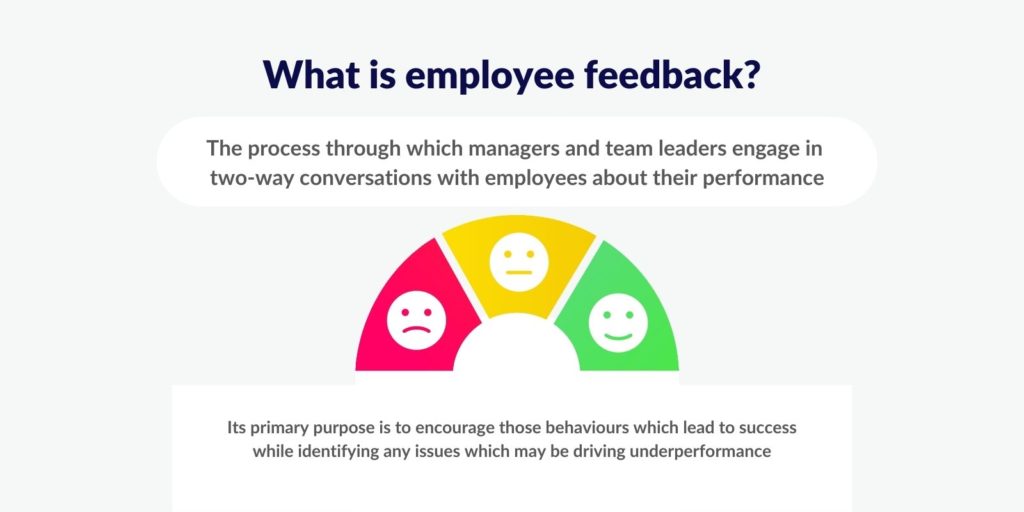
The Harvard Business Review article, What Good Feedback Really Looks Like, explores the delicate balancing act between providing positive feedback and constructive negative feedback. The article explains how:
“When you focus only on strengths, you lull people into believing there are no areas in which they need to improve. It also lets managers off the hook for fostering necessary — and sometimes difficult — development in their reports and co-workers, which ultimately compromise organisational effectiveness. So, instead of encouraging people to avoid negative feedback, we should focus on how to deliver negative feedback in ways that minimise the threat response.”
In this guide to employee feedback, we’ll explore the best practices for approaching constructive, negative, and other common types of feedback. We’ll also outline in detail some of the tools you can use to make the feedback process run as smoothly as possible, as well as actionable examples to help place these methods into context.
What is constructive feedback?
Traditional feedback was typically top-down, with managers dictating to an employee where they’ve gone wrong and outlining their recommended course of action. Constructive feedback needs to be approached with a coaching mindset, with managers engaging with employees in two-way conversations, figuring out the best course of action together, and maintaining an effective feedback loop.
The article from Gallup, Feedback Is Not Enough, outlines this coaching-driven approach to feedback, stating:
“Great coaching conversations are a two-way street. Employees should feel encouraged to share their perspectives, ask questions and bring issues to their manager. And it should be a busy two-way street. Frequent, meaningful conversations are key to fostering collaboration and engaged performance.”
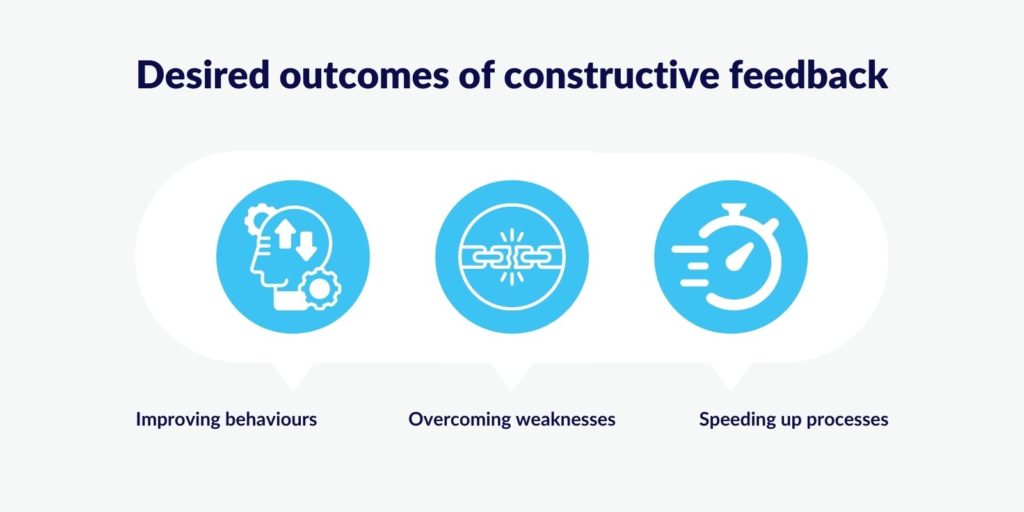
Constructive feedback is designed to nurture growth and development and should be framed from the outset with a positive outcome in mind. Rather than simply stating a problem with performance, it should have potential solutions embedded into it. The desired outcomes from constructive feedback should be improved behaviours, overcoming weaknesses, and speeding up processes.
What is negative feedback?
Delivering negative feedback is among the most difficult conversations managers, team leaders and HR professionals can have with employees. Employees on the receiving end of negative feedback are likewise put on the back foot, and can easily become defensive, despondent, and depressed.
As a result, negative feedback needs to be approached with caution and sensitivity to make sure the outcome is as positive as possible.
An article from Gallup, Why Employees Are Fed Up With Feedback, articulates the delicate balance faced by managers tasked with delivering negative feedback. The article explains:
“Feedback can, and sometimes should, be tough to hear. However, if an employee feels demotivated, criticised, disappointed or depressed after a feedback session with their boss, the manager failed.
“Congratulatory or corrective, feedback should motivate employees to do better work, position them for success and engage them … Gallup research shows that only 10.4% of employees whose manager’s feedback left them with negative feelings (felt criticised, demotivated, disappointed or depressed) are engaged, and four out of five say they’re actively or passively looking for other employment.
The article continues:
“On the other hand, workers whose manager’s feedback left them with positive feelings (felt inspired to improve or positive about knowing how to do their work better) are 3.9 times more likely to be engaged than employees who felt hurt, and only 3.6% of them are actively looking for another job.”
As such, negative feedback should, when appropriate, be framed in positive terms. The objective of any feedback should be to help improve performance, which means assuming the employee has good intentions.
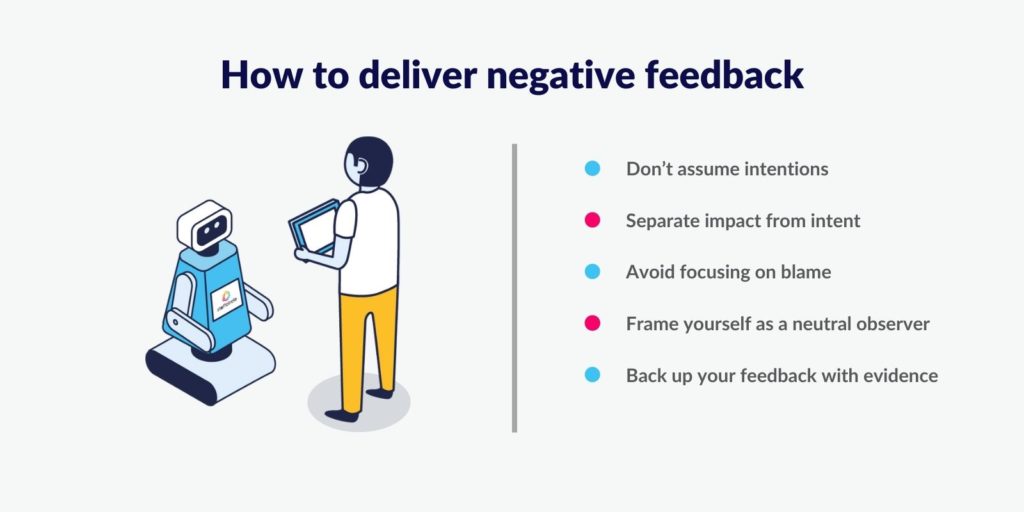
Here are some additional rules of thumb you should consider when delivering negative feedback:
- Don’t assume intentions. When an employee performs badly, it can be easy to assume the worst about their intentions. This means jumping to the conclusion that apathy, incompetence or another negative attribute is the driving force behind their poor performance. When dealing with poor performance, these assumptions should be set to one side so that constructive dialogue can take place.
- Separate impact from intent. Following on from the previous point, when dealing with poor performance a manager’s awareness is often limited to its impact on the company. To understand intent, articulating this impact can help the employee better understand where they went wrong.
- Avoid focusing on blame. There are instances where it is absolutely appropriate to focus on blame, for example when a member of staff explicitly and knowingly violates company policy. However, in many circumstances a focus on blame inhibits effective problem solving, and should be avoided in favour of conversations that seek to get to the heart of the matter.
- Frame yourself as a neutral observer. When delivering negative feedback, the mindset of a neutral observer is preferable. Underperforming employees are more liable to be on the defensive, and if the feedback is delivered in an aggressive manner, this defensiveness will be increased.
- Back up your feedback with evidence. If you’re delivering negative feedback about poor performance, it should be backed up whenever possible with credible data. This could mean presenting data from the company’s employee analytics reports which show targets being missed or sliding attendance.
Employee feedback examples
Now that we’ve examined the principles surrounding the key types of employee feedback, let’s take a look at some examples to place them in a real-world context.
Positive employee feedback examples
Positive feedback gives employees an improved sense of morale and lets them know they are doing great work. This in turn gives them a greater sense of purpose and commitment to their role and therefore reinforces the behaviours which lead to success.
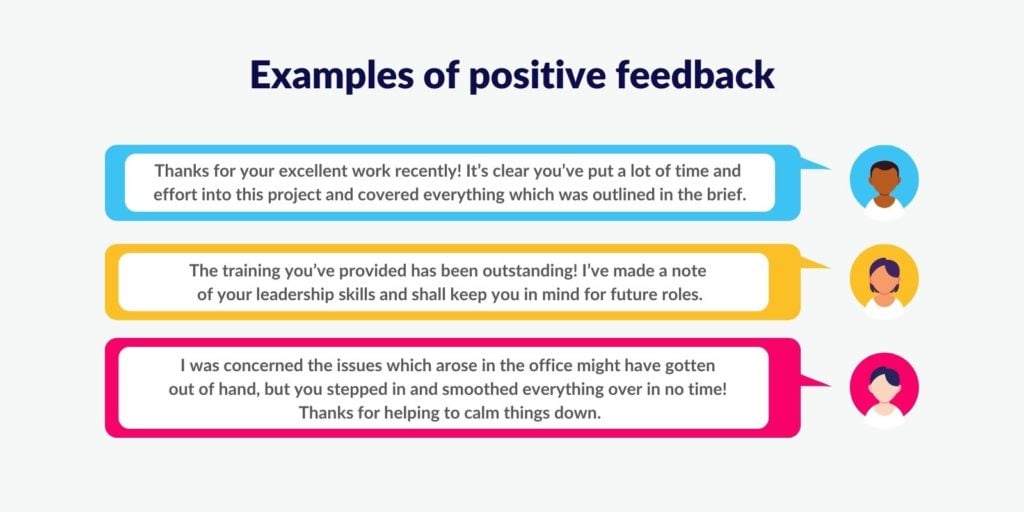
Here are some examples of positive feedback:
- Delivering high-quality work. “Thanks for your excellent work recently! It’s clear you’ve put a lot of time and effort into this project and covered everything which was outlined in the brief. The design preferences you opted for were much better than we’d hoped for!”
- Helping a colleague. “The additional training you’ve provided Sarah has been outstanding and has really helped her to get her head around the material. I’ve made a note of your leadership skills and shall keep you in mind for future roles.”
- Handling conflict on the team. “I was concerned the issues which arose in the office might have gotten out of hand, but you stepped in and smoothed everything over in no time! Thanks for helping to calm things down and get both sides to raise their issues in a polite and respectful manner.”

Constructive employee feedback examples
As previously mentioned, constructive feedback should be carried out with a priority for offering solutions to performance shortcomings.
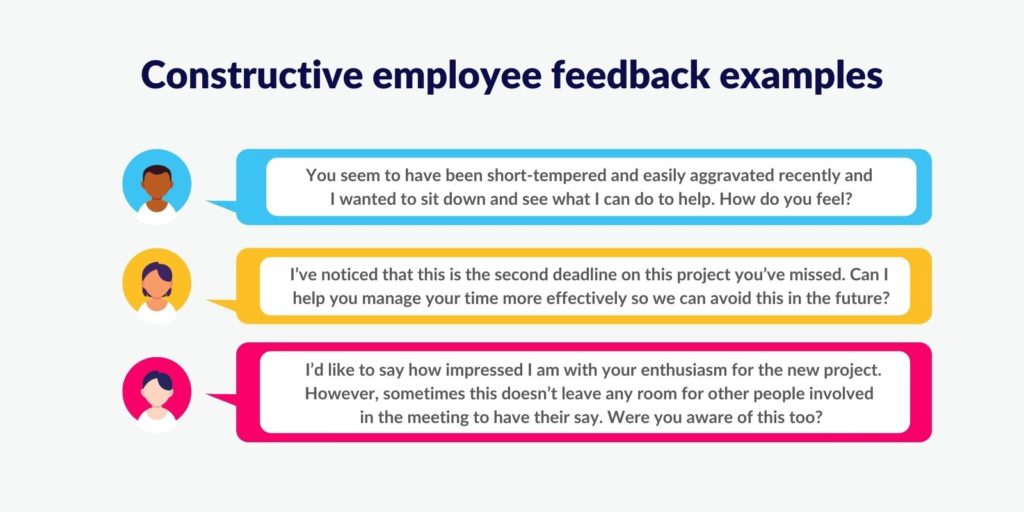
Here are some examples of what constructive employee feedback should look like.
- Poor communication skills. “Firstly, I’d like to say how impressed I am with your enthusiasm for the new project. However, sometimes this doesn’t leave any room for other people involved in the meeting to have their say. Were you aware of this too? If you can be mindful of others and give them an opportunity to contribute we’ll all get more out of these meetings.”
- Poor time management. “I’ve noticed that this is the second deadline on this project you’ve missed, and was wondering if I might be able to help you manage your time more effectively so we can avoid this in the future? Let’s take a look at your upcoming goals and work together to make these more realistic if you’re struggling to cope.”
- Dealing with a toxic attitude. “You seem to have been short-tempered and easily aggravated recently and I wanted to sit down and see what I can do to help. How do you feel? Is there something I can do to smooth things over with colleagues if you’re having any issues I’m not aware of?”
Tips to deliver employee feedback
We’ve examined positive, negative, and constructive feedback in detail. Now, let’s take a look at some general tips and best practices you can follow to make sure your overall feedback delivery is on point.
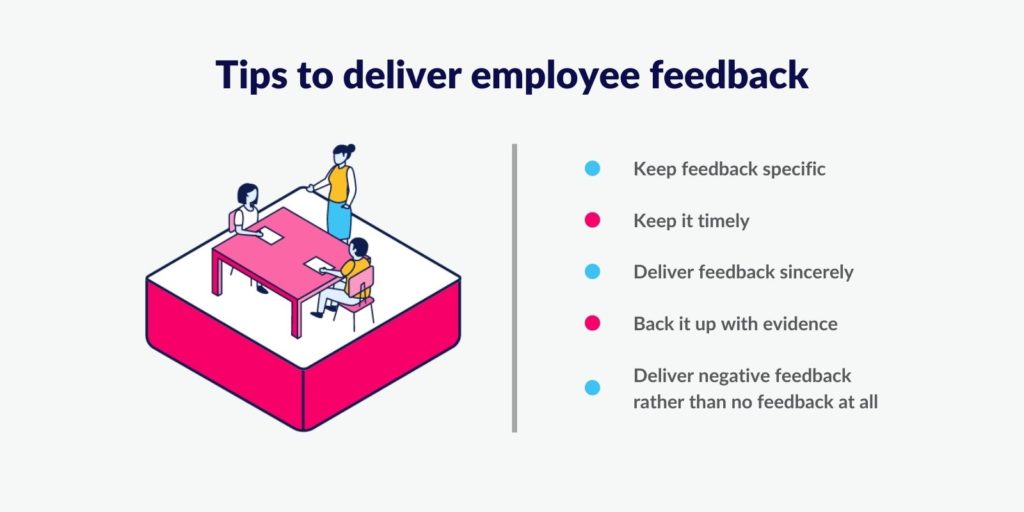
Keep feedback specific
When delivering feedback, try to avoid including any unnecessary information which might cloud the core issues. Instead, keep it focused on the one or two incidents that count the most, leaving aside any minor, if related, topics until the core issue has been properly addressed.
Deliver feedback sincerely
Whether you’re delivering positive, negative or constructive feedback, make sure you do so with sincerity. The tone of voice you adopt when giving feedback can make a huge difference in how it is received, and you don’t want the employee to feel you are giving praise begrudgingly.
Keep it timely
Whenever an issue comes up, be sure to address it as soon as you possibly can, rather than put it off until a later date. Achievements should be recognised and appreciated as and when they happen so they are fresh in the mind. Likewise, poor habits should be dealt with before they become ingrained behaviours.
Back it up with evidence
Facts, statistics, and raw data which back up feedback – whether positive or negative – helps to lend the feedback additional credence. “You’re frequently late for work” carries much more weight if it is backed up with a timesheet showing an employee’s tardiness.
Equally, high-performing employees will learn to improve even more if their great work is broken down to show exactly how and where they have excelled.
Deliver negative feedback rather than no feedback at all
It can be tempting to avoid conversations – and confrontation – when there is only negative feedback to deliver. This is a mistake since most employees would prefer to receive negative feedback than to receive none at all. Negative feedback can be acted upon, whereas no feedback will only lead to employees becoming disengaged and directionless.
Performance management software and feedback
Maintaining a consistent approach to employee feedback can be difficult, especially when managing large teams or departments. Fortunately, performance management software can be used to help make sure that feedback is not only consistent and regular but also backed up by appropriate performance-related data.
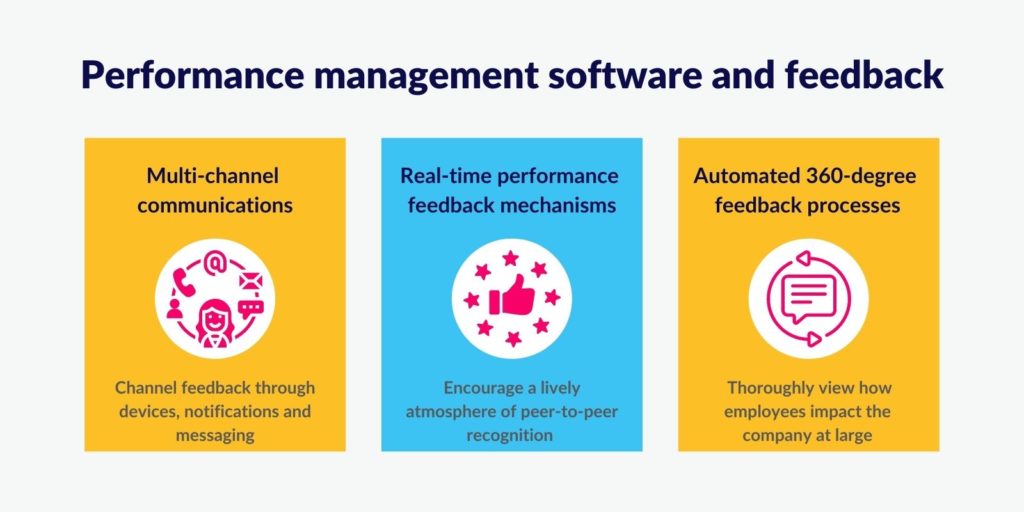
Some of the features and tools you can use through performance management software include:
Multi-channel communications
A strategy of continuous communication and feedback is difficult without the necessary means to communicate. Since many organisations are now adopting a hybrid working model, featuring on-site and remote working, a multi-channel communications platform is an essential component for feedback.
Such a platform allows businesses to channel ongoing feedback through:
- Desktop/laptop devices
- In-app notifications
- Mobile phones/SMS messaging
Booking and conducting regular feedback sessions, delivering emergency notifications, and logging receipt of communications all help to ensure feedback is consistent and regular.
Real-time performance feedback mechanisms
Performance management software includes mechanisms that encourage real-time feedback on performance. These can be linked directly to an employee’s objectives and key results (OKRs) so if anything urgent comes up managers don’t have to wait until the next one2one meeting to address them.
These real-time performance feedback tools are a great opportunity for a proactive approach to feedback and can be linked to company awards and recognition programs. Such programs encourage a lively atmosphere of peer-to-peer recognition on an ad hoc basis, whether praising a colleague for delivering a top-tier presentation or thanking someone for helping coach them to learn new skills.
Automated 360-degree feedback processes
When it’s time to conduct a more thorough review of an employee’s performance, 360-degree feedback offers a vital, holistic view of how they impact the company at large. By utilising customisable 360 degree appraisals, managers and team leaders can request feedback from colleagues, direct reports, other appropriate individuals in the company, and external clients.
Using employee engagement surveys
Employee feedback isn’t just about helping individuals to improve within their roles. To identify opportunities and obstacles for effective management, feedback needs to be a two-way conversation, with processes in place to allow employees to rate their own sense of engagement.
This means establishing surveys through which the employee can offer honest feedback of their own, giving business leaders clearer insights into issues affecting performance, engagement, and motivation.
Employee engagement surveys are a great way to set up a feedback process through which staff can air their honest opinions. By using employee surveys, managers and HR leaders can hone in on what makes employees thrive, and address any issues which inhibit strong performance.
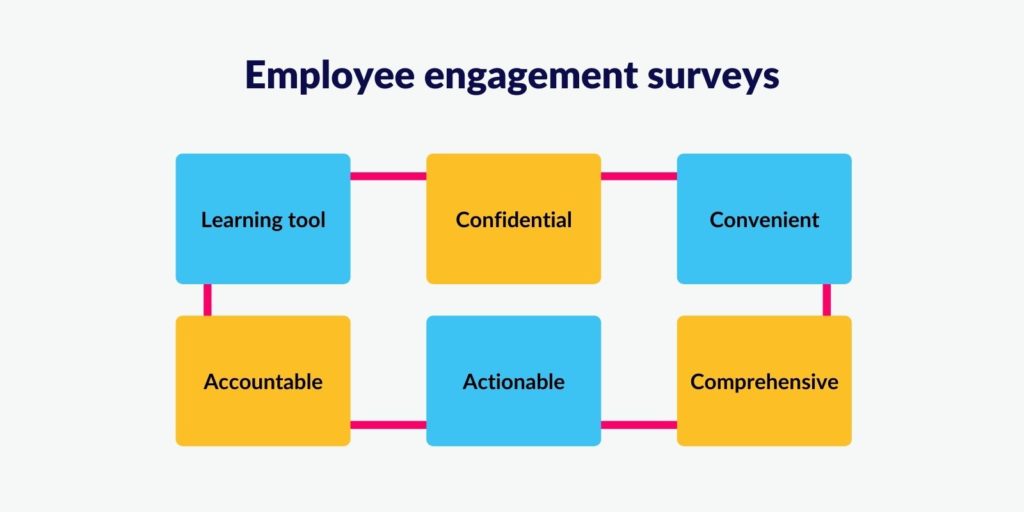
Employee engagement surveys are:
- Confidential. While some feedback is attributable to its source, employee engagement surveys can be conducted with confidentiality. This gives employees the opportunity to respond openly and honestly without fearing negative repercussions from their direct reports or other managers.
- A useful learning tool. Getting to the heart of performance issues isn’t easy for companies to do, particularly if employees are unable or unwilling to openly discuss obstacles they’re facing. Employee engagement surveys offer direct insights into what helps employees engage, and what should be avoided.
- Comprehensive. Employee engagement surveys aren’t just for gathering feedback from individuals. They can also be crafted to gain insights into team, departmental and company-wide engagement levels.
- Convenient. Once an employee engagement survey has been created, it can be saved as a template for further use. These templates can also be quickly customised to fit different circumstances, while the results can be stored for thorough data analysis.
- Actionable. Employee engagement surveys cut to the chase and offer insights into what drives engagement. This means they are fully actionable, giving a clear understanding of what needs to change in order for engagement to improve.
- Accountable. The levels of engagement and motivation among employees is in large part a consequence of how the organisation operates. As such, employee engagement surveys give the workforce an opportunity to hold the company accountable for the role they play, highlighting areas of concern that need addressing.

Using employee engagement surveys brings a range of benefits to an organisation. Such benefits include:
- Raising awareness of any safety issues which might have been overlooked
- Delivering insights into how effective training and other skills-related programs are for improving engagement and performance
- Helping to develop policies that improve the mental and physical well-being of employees, such as flexible schedules, the availability of healthy foods, and other activities which promote well-being
- Improving employee satisfaction by making it clear the company is working hard to create the best environment possible for its workforce
- Reducing overall absenteeism through a commitment to higher engagement
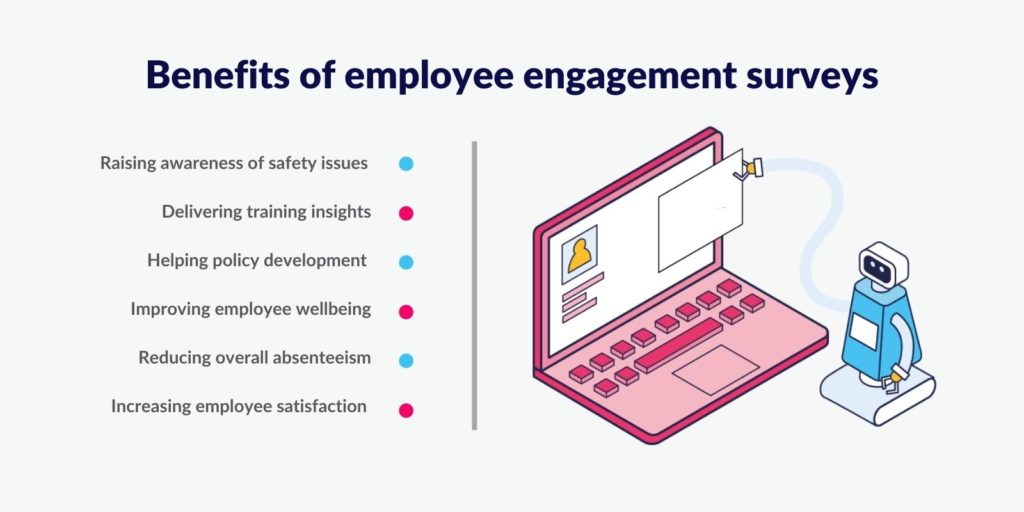
Ultimately, a more engaged workforce is more productive, more motivated, and delivers higher dividends on the company’s bottom line. By using employee engagement surveys to measure and track this sentiment in the workforce, companies can work to consistently improve engagement through a better understanding of what works and what doesn’t.
Using employee net promoter scores
Like employee engagement surveys, employee Net Promoter Scores (eNPS) are a good way to allow employees to deliver anonymous feedback to the company. Based on the Net Promoter Score (NPS), originally developed by Fred Reichheld, Bain and Co., and Satmetrix in the 1990s to measure customer loyalty, an eNPS score lets the company understand how their employees feel about how well the company is looking after them.
Setting up an eNPS system is easy, with a range of questions included relating to employee sentiment in the workplace which the respondent can rate on a scale. How happy they feel in their role, what level of support they receive, how manageable their workload is, and other areas can be included in the survey.
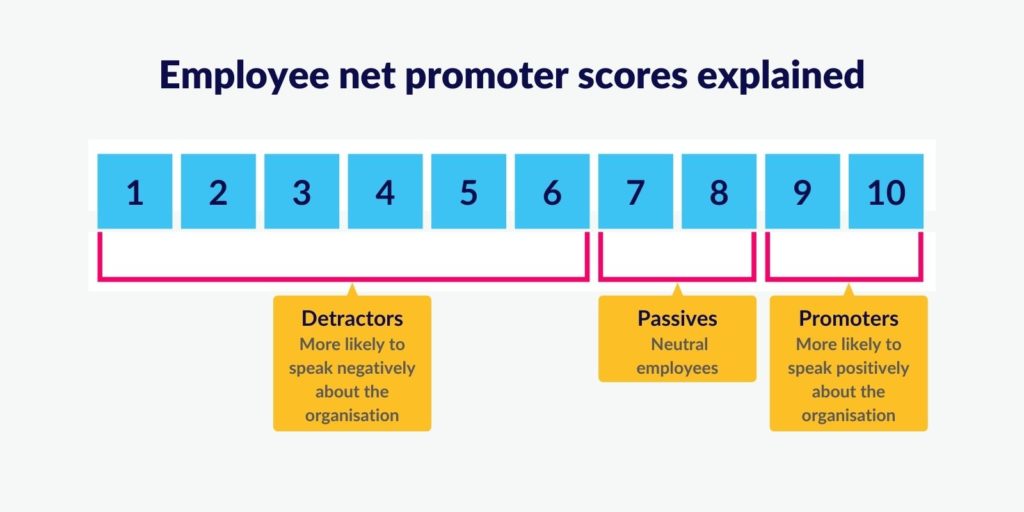
Typically, employees respond on a ten-point scale where 1 is not happy and 10 is satisfied. These scores are then broken down as follows:
- 9-10: Promoters – employees who are more likely to speak positively about the organisation
- 7-8: Passives – neutral employees
- 0-6: Detractors – employees who are more likely to speak negatively about the organisation
These scores can be tracked over time, giving business leaders insights into improvements in engagement and well-being, as well as failure to level up the company’s commitment to engagement and well-being.
If the score is falling, HR is then in a position to reach out to employees to see what can be done to improve conditions and increase the overall happiness of the workforce.
Measuring employee performance after feedback
When you’ve finished delivering feedback, systems need to be put in place to allow the employee’s performance to be measured. This is particularly important when the feedback is related to poor performance which needs to be addressed. Here are some methods you can use to measure employee performance after feedback.
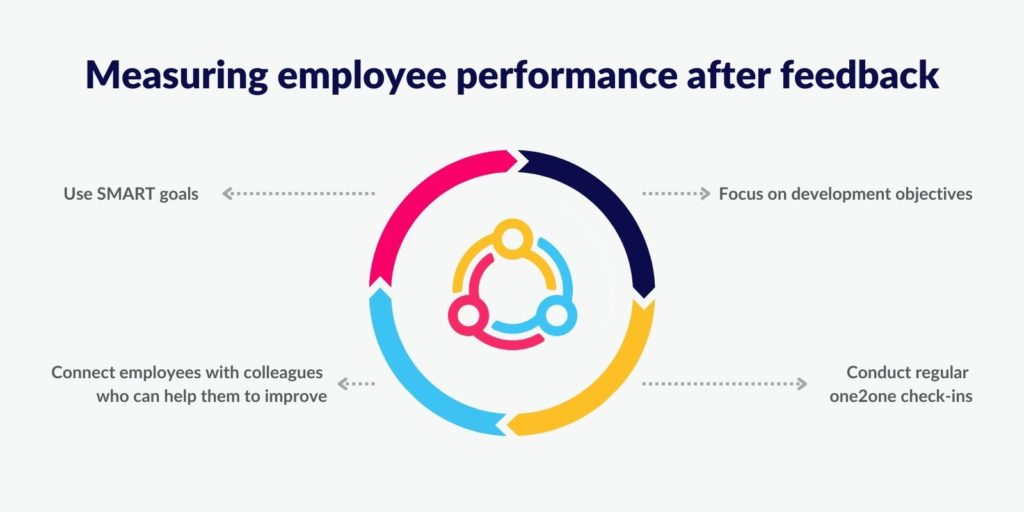
Use SMART goals
Whether you’re dealing with an underperformer who needs to up their game or looking to enhance the skill set of a potential candidate for a leadership role, SMART goals are an excellent tool for measuring post-feedback performance.
You can update existing work-related goals in accordance with the outcome of feedback conversations, or if necessary introduce new goals to help the employee improve. These goals can be tracked as key performance indicators (KPIs) via performance management tools.
Focus on development objectives
Continuous feedback and ongoing development go hand in hand. Employee development can come in a range of forms, from learning relevant skills to better perform their role, to developing soft skills to improve communication and leadership ability.
Clearly articulated development objectives give employees an actionable plan to follow up on feedback. Development objectives go beyond the basic goals required for their role and help them develop skills that offer opportunities for personal and career growth.
These goals can also be tied to their personal development plan (PDP), assessing strengths and weaknesses so they can build on the latter and work to overcome the former.
Conduct regular one2one check-ins
One2one check-ins should be carried out on a regular basis regardless of whether or not any performance issues need addressing, and provide the backbone for ongoing feedback. They can be used to keep on top of any concerns managers or employees have, as well as being an opportunity to bring up any accomplishments.
You can easily schedule regular one2one check-ins through performance management software, with any upcoming meetings highlighted in the software’s visual dashboard. Any follow-up action can also be noted in the system and signed off once it has been completed.
Connect employees with colleagues who can help them to improve
The continual conversations aspect of the feedback process shouldn’t be limited to just manager-to-peer discussions. Whenever possible, employees should be encouraged to engage with one another on a regular basis. This can be achieved in a variety of ways and with a range of tools.
Social intranets and forums can be used to give staff a digital space where they can freely discuss their work and roles, sharing ideas for how to improve processes. If there are members of staff working remotely, they can be connected with colleagues via a virtual team, so they don’t become isolated from their peers.
Make employee feedback part of company culture
Businesses which place a strong emphasis on the importance of feedback are far more likely to be successful than those which don’t. This means placing employee feedback at the heart of the company culture, messaging this principle throughout the workforce.
The article from Deloitte, Avoiding the Feedback Monsters, explains just how positive the impact of a culture of feedback can be if implemented properly. It states:
“There was a recent report from Bersin by Deloitte … and it showed that organisations achieve a 21-percent boost in business results when leaders embrace the culture of coaching. It’s not just about people being productive in the workplace, but it’s about a whole lot of stuff. Because if you don’t have that culture of coaching or feedback on a regular basis you can lose money, you can lose productivity, and lose lots of things.”
There are a variety of ways organisations can promote consistent feedback through their culture and values. On a fundamental level, reiterating the importance of feedback as a core value through branding and other messaging helps employees to understand their feedback will be taken on board.
Ultimately, the best way to build a culture of feedback is for business leaders and managers to demonstrate their own willingness to participate in ongoing feedback. By modelling the behaviours they expect from others, they can lead by example and encourage feedback as an aspect of everyday life at the company.





